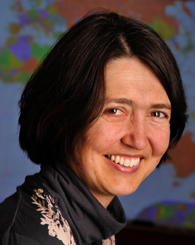Good Ideas, Multiplied: How NGO, research collaboration is boosting social entrepreneurship
Social entrepreneurs are celebrated for bringing new ideas to the table. Whether it’s a technological innovation, a new distribution model, or a high-quality service, social entrepreneurs have the potential to meet important needs for the poor around the world.
But is a great idea enough to have the intended impact? While entrepreneurship celebrates the new, what role should existing research networks and NGOs, who bring deep sector expertise and trusting relationships with target communities, play in supporting social entrepreneurship? Two events that took place at UC Berkeley this past week shed interesting perspectives on this question.
In a speaking event celebrating the launch of the new Institute for Business and Social Impact at the Haas School of Business, Dr.  Helene Gayle, the president and CEO of CARE USA, (pictured left) emphasized that established organizations like CARE can offer social entrepreneurs two important resources: distribution at scale and knowledge of local norms. She highlighted a number of examples, noting how USAID has helped launch a handful of viable and sustaining enterprises, but one story stood out in particular.
Helene Gayle, the president and CEO of CARE USA, (pictured left) emphasized that established organizations like CARE can offer social entrepreneurs two important resources: distribution at scale and knowledge of local norms. She highlighted a number of examples, noting how USAID has helped launch a handful of viable and sustaining enterprises, but one story stood out in particular.
Gayle recalled an initiative between CARE and Danone to strengthen the milk supply chain among largely female household-level dairy producers. The project aimed to give small producers higher and predictable income from dairy production while also improving the quality of Danone’s available milk supply in the country. Danone could have worked alone, but small milk producers in Egypt are fragmented, produce milk of variable quality, and operate in a highly specific cultural context. CARE was well positioned to address these challenges and organized central milk collection centers that enabled Danone to source at the volumes needed while still engaging small capacity producers, Gayle said. The combination of CARE’s reach into the community and expertise in establishing rural distribution systems, and Danone’s business priorities resulted in a successful platform for “shared value.” Neither side could have succeeded alone. (Find out more about the CARE/Danone initiative by clicking here and here).
The need for partnership not only exists among large corporations looking for social impact opportunities, but also among emerging social entrepreneurs. In a research symposium hosted by the Center for Effective Global Action (CEGA) at the University of California in partnership with Abdul Latif Jameel Poverty Action Lab (JPAL), researchers noted the many ways that enterprises tackling agricultural issues could learn from the available data and adjust their approach to achieve the maximum impact possible.

For example, Economics Professor Craig McIntosh (pictured right) explained that some insurance products that are designed to help mitigate weather risk for smallholder farmers actually result in farmers increasing their risk exposure by adopting more weather dependent crops. 
JPAL Executive Director Rachel Glennerster (pictured left) presented research that showed new high-yield seed technology did little to help farmers increase yields and strengthen their children’s nutrition status unless it was affordably priced and accompanied by technical training. A social enterprise focused solely on the uptake or distribution of this technology could have easily overlooked these valuable nuances.
Social entrepreneurship is often discussed through the lens of replacing the old “broken” aid system for a new lean model of service. However, for those interested in achieving true social impact at scale, this is very much a false dichotomy. At his keynote address at the CEGA symposium Andrew Youn (pictured below), co-founder and executive director of One Acre Fund, emphasized a value chain for social impact that depends on four key elements:
Impact ? Adoptability ? Simplicity ? Operability
 He noted that researchers offer unparalleled insights into what types of products and services actually achieve significant social impact, and the likelihood of adoption. However, research alone cannot deliver solutions to thousands or millions of people. For promising models it is up to established NGOs and social entrepreneurs to find ways to make the offering as simple as possible and to make it available at a scale that actually counts. It is precisely in this gap of simplicity and operability that social entrepreneurs can thrive. Bolstered by partnerships that expand an entrepreneur’s distribution across a region and influence into particular communities, social entrepreneurs can help bring proven technologies and services to the people who need them the most.
He noted that researchers offer unparalleled insights into what types of products and services actually achieve significant social impact, and the likelihood of adoption. However, research alone cannot deliver solutions to thousands or millions of people. For promising models it is up to established NGOs and social entrepreneurs to find ways to make the offering as simple as possible and to make it available at a scale that actually counts. It is precisely in this gap of simplicity and operability that social entrepreneurs can thrive. Bolstered by partnerships that expand an entrepreneur’s distribution across a region and influence into particular communities, social entrepreneurs can help bring proven technologies and services to the people who need them the most.
Aarthi Rao is a MBA candidate at the Haas School of Business at UC Berkeley focused on social impact strategy.
- Categories
- Education, Impact Assessment, Social Enterprise
